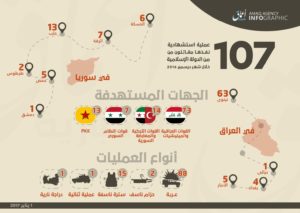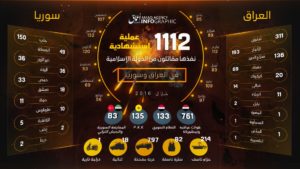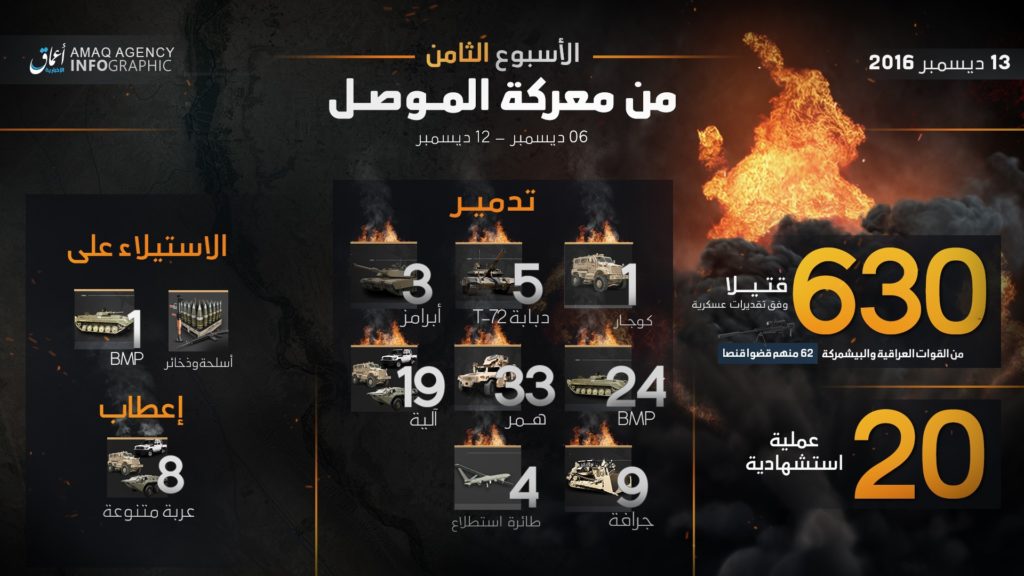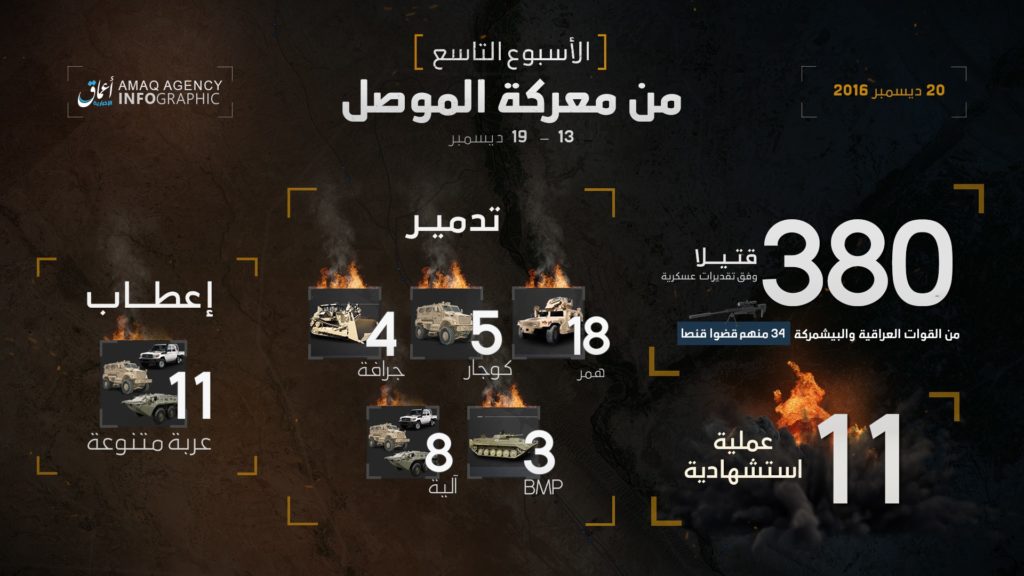The Islamic State’s Amaq News Agency claims that the so-called caliphate carried out at least 1,141 “martyrdom operations” (suicide attacks) in Iraq, Syria and Libya in 2016. The overwhelming majority of these, 1,112 in all, were launched in Iraq and Syria.

On Jan. 1, Amaq posted an infographic (seen on the right) summarizing 107 “martyrdom operations” in Iraq and Syria for the month of Dec. 2016. As The Long War Journal repeatedly documented last year, Amaq produces a similar image each month. The total for all twelve months of 2016 is 1,141 suicide bombings, including 29 in Libya.
If Amaq’s figures are accurate, then the Islamic State set a new record high for suicide attacks in 2016. Indeed, the scale of such operations is incredible, even by the standards of modern jihadist organizations. For example, the Taliban claims that its members were responsible for just 32 “martyrdom” attacks during the same time frame.

Earlier today, Amaq also published an infographic (seen on the right) summarizing the group’s 1,112 “martyrdom operations” in Iraq and Syria. The majority of these, 761 (or 68 percent), were aimed at Iraqi government forces or Kurdish Peshmerga fighters. The infographics do not separately list those bombings that targeted Iranian-backed Shiite militias that fight alongside the Iraqi government.
Kurdish fighters from the Kurdish People’s Protection Units (YPG), which is affiliated with the Kurdistan Workers Party (PKK), were the second most frequent target of the Islamic State’s “martyrs.” According to Amaq, 135 such operations targeted the PKK/YPG. Most of these took place in northern Syria, where the two sides have been engaged in heavy fighting. The PKK is a US-designated terrorist organization. The YPG has helped deliver some of the Islamic State’s biggest losses since 2014, including in Kobane.
Another 133 suicide bombers struck fighters loyal to Bashar al Assad’s regime in Syria. The two sides frequently clash in the Homs and Deir Ezzor provinces. The Islamic State also carried out high-profile “martyrdom” operations against the Syrian regime elsewhere in 2016 as well.
The remaining 83 “martyrs” were deployed against Turkey’s armed forces and allied rebel organizations in northern Syria. Turkey launched Operation Euphrates Shield in August and quickly claimed territory from the so-called caliphate along the border. Abu Bakr al Baghdadi’s loyalists have been trying to stymie the Turkish-led offensive on Al Bab, a town in the northern part of Syria’s Aleppo province, and some of the bombings took place in the neighboring villages.
The Islamic State has become particularly adept at using vehicle-borne improvised explosive devices (VBIEDs). According to Amaq, 797 of the 1,112 suicide attacks in Iraq and Syria in 2016 relied on VBIEDs. Another 18 were dual operations involving vehicles. Therefore, fully 73 percent of the bombings used VBIEDs. The remaining suicide operations used explosive belts (214), bomb vests (82), or a motor bike (1).
The Long War Journal has noticed a small discrepancy in Amaq’s reporting. The Islamic State’s propaganda arm listed suicide attacks in Libya on several of its monthly infographics in 2016, but stopped doing so in the latter third of the year. For instance, Amaq separately reported that tanks and various other vehicles belonging to General Khalifa Haftar’s men were destroyed in “a martyrdom operation in the customs zone west of Benghazi” on Dec. 18. However, this bombing is not listed on Amaq’s infographic for December (seen above). This means that some suicide attacks reported by Amaq in Libya, as well as elsewhere, are not included in the organization’s tallies. The infographic tallying 1,112 suicide attacks in 2016 excludes Libya entirely.
The battle for Mosul
In October, the US military, Iraqi government, Kurdish forces, Iranian-backed militias and others began an offensive to retake Mosul, which is located in Nineveh province. Mosul is one of the Islamic State’s two de facto capitals, so it is unsurprising that the group has dispatched an incredible number of suicide bombers in its defense of the city.
In fact, according to Amaq, 220 “martyrdom operations” were carried out during the first ten weeks of the battle for Mosul. The bombings during this ten week period, which began in mid-October and ended on Dec. 26, account for nearly 20 percent of the claimed suicide attacks in 2016 across Iraq and Syria combined.
The figure for the battle of Mosul is based on separate infographics produced by Amaq specifically for the fight in and around the city. The infographics for the first seven weeks of the battle for Mosul were previously reproduced by FDD’s Long War Journal. [See: “Islamic State defends Mosul with dozens of suicide bombers” and “Islamic State has claimed more than 1,000 suicide attacks thus far in 2016.”] The infographics for weeks eight through ten of the battle can be seen below.
Claiming suicide bombings at a historically high rate
As The Long War Journal has previously reported, the Islamic State claims to have carried out suicide bombings at a historically high rate in 2016.
Amaq’s infographics indicate that the group launched an average of 93 “martyrdom operations” in Iraq and Syria per month throughout the year. This figure does not include the suicide bombings in Libya and elsewhere, which would only make the average even higher.
According to open source data compiled by the National Consortium for the Study of Terrorism and Responses to Terrorism (START), all terrorist organizations around the globe carried out 906 (76 per month) suicide attacks in 2015 and 739 (62 per month) in 2014. The year 2015 was the previous high water mark for suicide bombings. Many of those attacks in 2014 and 2015 were orchestrated by the Islamic State, but other organizations’ “martyrs” are included in the totals as well.
Therefore, the Islamic State’s figures suggest that the organization set a new record for suicide bombings in 2016 all by itself.
However, there are important caveats to keep in mind when assessing Amaq’s claims.
First, it is not possible to validate the total figures provided by Amaq. The Islamic State propaganda arm does post individual claims for many of the “martyrdom operations” tallied on its infographics. These statements indicate a location and target for each “martyr,” but this is not independent verification as it comes from the same source (Amaq). Furthermore, while open source reporting corroborates many such operations, it is unlikely that all of the suicide attacks are tracked in publicly-available sources. The fog of war often makes it difficult to document the precise details of bombings in chaotic war zones.
The identities of many of these attackers are not known. The Islamic State has used children or adolescents in at least some of its “martyrdom operations.” Such young people cannot be truly considered willing “martyrs.”
Some suicide bombers fail to reach their intended targets, but are probably included in Amaq’s totals anyway. Press reports have detailed how many Islamic State operatives fail to hit their mark prior to blowing themselves up. The US and its allies often destroy VBIEDs before they can do any damage.
It is also possible that Amaq exaggerates the efficacy of the group’s “martyrdom operations” by overstating the casualties caused and the total number of targets destroyed (including enemy vehicles) in the resulting explosions.
Most of the Islamic State’s suicide bombings are now defensive in nature, meaning that a large number of “martyrs” are being deployed as the caliphate’s grip on territory loosens. This can be seen in and around Mosul, north of Raqqa, Syria as well as in Sirte, Libya. All three cities are considered key to the Islamic State’s caliphate claim. As the group’s hold on Sirte began to slip during the summer of 2016, for example, the jihadists used a number of suicide bombers to slow their enemies’ approach. Eventually, Sirte fell to local Libyan forces backed by the US and its Western allies anyway. The same methods are being employed around Mosul and north of Raqqa.
It is also important to remember that suicide attacks are just one of the many tactics employed by the Islamic State.
Still, there is no question that Baghdadi’s men are relying on suicide bombers at a remarkable pace.
If Amaq’s data are accurate, the two months that witnessed the most suicide bombings by Baghdadi’s operation were October (120) and November (132). September saw the fewest suicide attacks with 53, according to Amaq.
Amaq News Agency’s infographics for weeks eight through ten of the battle for Mosul:











4 Comments
Thanks, Barry! That can be a part of your legacy too.
Echos of Japan toward the end of ww 2 . Frantic crazed pilots forced into suicide missions. Some willing , while questionable numbers would have rather not flown to their certain death.
Will IS commanders follow the same path when they run out of candidates , forced or willing to carry out the ‘final mission’ ?
ISIS IS TO U.S. DIPLOMACY POSTED TERROR GROUPS SIMILAR POP SINGERS.
According to Lt. Gen. Sean MacFarland: approx 45k ISIS terrorists were killed in total so far by the coalition.
Interestingly, he stated that since September 2015, 25k ISIS terrorists have been killed, and CIA estimated(also in september 2015) that there are approx 30k active ISIS fighters.
Rough stats below:
Per the above statements made publicly by the gen. MacFarland and the CIA, that’s roughly approx 17% or approx. 5000 active fighters left on the battlefield in Syria and Iraq combined as of Augut 2016, hence MacFarland made the statement in August 10th of 2010.
First coalition publicly acknowledged strike against ISIL hapened on August 8th 2014, since then over . 14K coalition strikes were confirmed and Inherent Resolve costed the US tax payers over 8.5 billion $, and up to December 2016, ISIL has lost:
164 tanks
388 HMMWV’s
2050 staging areas
79448 isis controlled buildings
8638 fighting positions
2638 oil infrastructures $$
10074 other targers
Totaling approx 31900 assets per DOD’s Inherent Resolve website .
Well, if that’s the case ….. and this article on LWJ states that per ISIS’s Amaq magazine,they slightly increased the number of their suicide missions to approx. 93 suicide missions alone/month…. well, if again, in August 2016 ISIS would have potentially had 5K active members left, and there has been approx 90 isis members dead in suicide missions/ month and the Inherent resolve would take out approx 20 isis per week, then NUMBERS DON’T ADD UP PEOPLE !!!!
It’s more likely that ISIS would have well over 170K active members in the region, not counting E Africa and Europe.